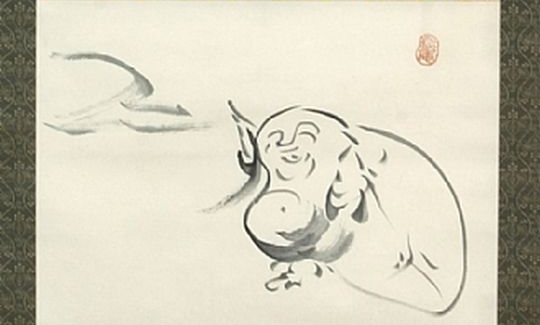This exhibition is the third of its kind since the Tikotin Museum of Japanese Art reopened its doors to the public in 1995. We are proud to present, once again, a broad spectrum of art works donated to or acquired by the Museum during the years that have elapsed since "New Acquisitions II" took place in 2004. Included are modern prints, calligraphy, paper dolls, ceramics, clothing accessories and other items.
The Museum's collection has been augmented in various ways over the years. We purchase modern and traditional works of art, mainly in the genres that will enrich and sustain the collection, but also in new fields. Some collectors wish to donate their own collections to the Museum. Artists exhibiting, either solo or in group exhibitions, each present a work to the Museum. Indeed, some Japanese artists who have never been exhibited here also donate works to the collection.
The collection has also been enlarged by contributions and gifts from collectors. As an example, in this exhibition we are displaying, for the first time, items from a collection of painted scrolls donated to the Museum by Shulamith Rubinfien of California and her late husband, in 2005. The collection includes ink paintings in the Zen and Haiga styles from the 19th and 20th centuries, in some of which short poems are integrated. Zen paintings were mostly created by monks (who were not professional artists) because this permitted them to fulfil the process intended to reach spiritual enlightenment. Ceramic vessels donated by Bernie and Sue Pucker of the Pucker Gallery in Boston include a tea-bowl by Tomoo Hamada - grandson of the renowned Shoji Hamada, and another by the artist Makoto Yabe; a vase by the potter Matsuzaki Ken; and one by the Korean artist Sung Jae Choi. On display are also prints by the renowned Tetsuya Noda, donated by Shoshana and Uri Sivron of Haifa, and a Japanese wedding robe donated by Nilli Wasserman, also of Haifa.
In 2007, the Museum exhibited "Flying White", works by the calligraphy artist Ishii Kazuo, who later donated eight fine works from that exhibition. They derive from the four faiths of the Far East - Shinto, Buddhism, Confucianism, and Tao. The calligraphic symbols represent profound tenets related to each of these beliefs.
Ishii was born in 1957 in the Saitama Province of Japan. His first calligraphic attempts were made at the age of nine. He studied at Waseda University in Tokyo, and his works have been widely exhibited since 1989. In 1990 he exhibited at Ueno no Mori in Tokyo, and in 1991 at the historic Beijing Museum. His works were chosen for the cover of the Japanese journal of calligraphy, and in 2006 he participated in a group exhibition at Vilena in Lithuania.
The current exhibition presents, for the first time, two etchings by Hamanishi Katsuneri - "Serenity no.5" and "Silent Opus no.11", acquired by the Museum in 2008 from the Yoseido Gallery in Tokyo. Hamanishi (b. Hokkaido, 1949) completed his studies at Tokai University in 1973, and in 1987-88 studied at the University of Pennsylvania. He has received many prizes, and his works have been exhibited in Tokyo, Kyoto, Paris, San Francisco, Philadelphia, and elsewhere. Today, Hamanishi is one of the most important mezzotint print artists in the world. In his latest works he incorporates gold and silver according to traditional Japanese techniques. His works are in museum collections worldwide, including the Metropolitan Museum and MOMA in New York, the Chicago Art Institute, the National Museum of Krakow, and the Taipei Museum of Art.
We are also exhibiting dolls created by Ruth Falk, representing characters from the Noh dramas, and donated by her after her exhibition here in 2008. Her inspiration for these works came after she had attended several Noh performances during her travels in Japan, where dolls are considered as valued and cherished works of art, not merely toys for children, and are collected and displayed in homes and in museums.
In 2009 the artist Masa Kumagai presented an installation at the Museum, a work in paper. Kumagai was born in Iwate Province in 1951. She has exhibited in Japan, France, Korea, Germany and other venues. In her works she copes with new challenges by means of years of experience in preparing strips of paper from delicate, fragile fibers. After her exhibition here, the artist donated two paper works that she created in 2005.
Since 2004 there has been an impressive growth in the size of the collection so that we are unable to present all of our new acquisitions in a single exhibition. We take this opportunity to offer our grateful thanks to all the contributors and artists who support the Tikotin Museum of Japanese Art and enrich its collections.


